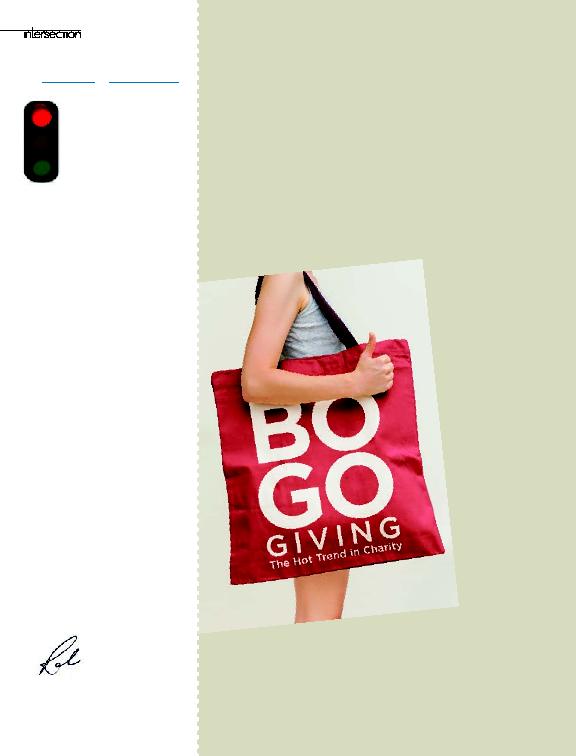
O
ne of the hottest trends in charitable giving currently is
the charity/business hybrid commonly known as BOGO
(Buy One, Give One). Based on percentages, there is a good
chance that right now you own a pair of TOMS shoes, a "cause"
t-shirt, or perhaps even a whistle � all products that are the result
of this BOGO wave. What is often not readily known however, is how these com-
panies impact social change.
The answer varies widely based upon the business model, mission and poli-
cies; but by examining several BOGO business models, we can get a better idea
of the pros and cons of participating in the BOGO craze.
The
fi rst and simplest model, or what I call Simply BOGO, literally donates
exactly one item for the item you purchase. TOMS, the creator of this model, is a
good example; but this business model is the most risky. History has shown that
companies or organizations that merely drop donated goods, often deplete local
economies by giving free goods that would have otherwise been purchased by
local vendors. While TOMS does partner with local organizations that distribute
the shoes, with this model
there is often no continuous
presence, or attempt to tar-
get the reasons behind the
need for donations. Fur-
ther, an aid model solely
based upon donations can
keep the poor dependent
on aid. Providing low
cost manufacturing and
education in a local area
would instead provide
jobs, revive a local
economy and provide
locals with the means
to buy the goods they
actually need, when
they need them.
The Buy One Give
Some model is used
by companies like
Warby Parker and
Sevenly, and offers
an alternativer to the
BOGO model. War-
by Parker partners
with VisionSpring,
which trains low-
income individuals
to sell glasses in
their local communities.
Sevenly partners with a new cause each week by do-
nating $7 from each t-shirt sale. While policies differ from company to company,
by working with VisionSpring, Warby Parker's model has targeted the reasons why
communities and individuals don't have access to eyecare, and has as its core
mission economic development (treating the disease not the symptom). With the
Sevenly model, one would have to research each cause they donate to each week
to see the impact they make but many of the organizations they work with are
non-pro
fi ts and their charity ratings are posted online.
W W W . S A I N T E R S E C T I O N . O R G
Vantage Point
Most of us enjoy wearing
clothing that looks good.
And I would venture to guess
that there are a good number
of us who wouldn't think twice
about helping others who
are in need. What if we could
wear fashionable clothing and help those
in need at the same time? Well, thanks
to more than a few enterprising orga-
nizations we can do just that; it's called
BOGO, or Buy One, Give One � with sev-
eral variations on that theme.
@rreardondc
by Melissa Jones
In this issue, we've taken a look at these
BOGO models and are wondering if such
charitable endeavors are worth the effort.
BOGO organizations are changing the
way we can help feed the hungry and
clothe the naked, but the question re-
mains, are these changes making things
better?
You'll also read an intriguing article about
how actor George Clooney has chosen
to invest signi
fi cantly in justice and fair-
ness. Granted, Clooney has more money
than anyone reading this, but the point
is that he's doing something he feels
compelled to do.
There's a story about the founder of The
Salvation Army, William Booth, whose
son expressed concern that there were
homeless individuals languishing under
the bridges of London. Booth's response
to his son came in two simple words:
"Do something." As we look around our
neighborhoods and communities, we
would do well to heed Booth's words �
we should all "do something."
17-20_Intersection_OCt2013_Working2.indd 18
9/13/13 4:07 PM
